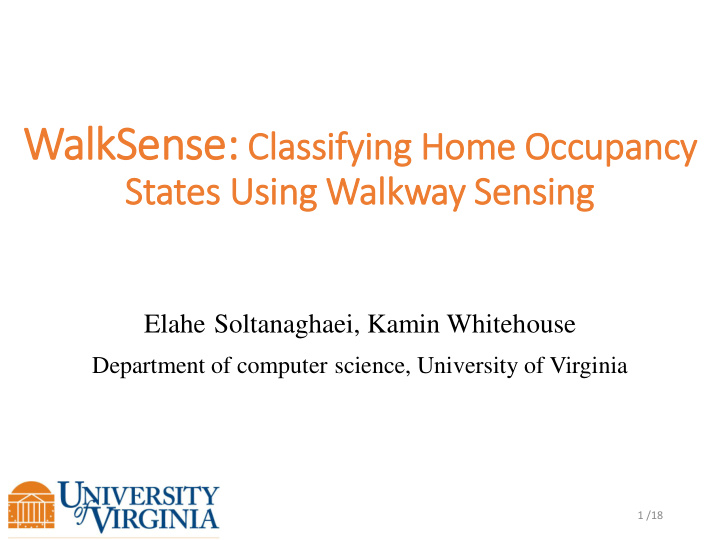



WalkSense: Cla lassify fying Home Occupancy States Usin ing Walk lkway Sensing Elahe Soltanaghaei, Kamin Whitehouse Department of computer science, University of Virginia 1 /18
Motion ≠ Occupancy 2 /18
Motion ≠ Occupancy 3 /18
Walkway Sensing 4 /18
Overview Active Sleep Active Sleep Away Away Bedroom Living room Bathroom Bedroom 5 /18
Outline • WalkSense: Occupancy detection algorithm • Automatic training feature • Evaluation 6 /18
WalkSense Candidate Transition Events Sleep Walkway Active-zone events Time 7 /18
Training WalkSense How to train the models? By exploiting the WalkSense in offline mode 8 /18
Training WalkSense • Candidate Sleep/Away Intervals: Inactivity longer than K Candidate Away Intervals Outside Walkway Active-zone events Time Sleep Walkway < K Candidate Sleep Intervals Automatic Labeling No user involvement Incremental Training Improve detection model over time 9 /18
Experimental Setup • 350 days worth of data bedroom Living room bedroom Living room Living room Kitchen Kitchen bedroom bedroom Kitchen bathroom House B House A House C, D Study room Kitchen bedroom Living room Living room Kitchen bedroom House E Aruba 10 /18 Active Sensing Zone Outside Walkway Zone Sleep Walkway Zone
Experimental Setup • Baseline: HMM-base • Evaluation Metrics • Energy penalty: away or sleep periods are wrongly detected as Active • Comfort penalty: Active periods are wrongly detected as Sleep or Away 11 /18
Experimental Setup 61% of the day outside home, or sleep 12 /18
Evaluation 30% lower energy penalty 32% lower comfort penalty 13 /18
Evaluation WalkSense HMM Baseline Actual Actual Predicted Predicted 95% vs. 83% Accuracy 14 /18
Analysis Training Size Effect 15 /18
Conclusion • WalkSense: Occupancy Detection algorithm based on Walkway Sensing • Higher Accuracy • Fewer Sensors • 96% Accuracy with 30% and 32% lower energy and comfort penalty • Limitation : Assumes direct relationship between Occupancy States & Occupancy zones. • TV • Study Desk 16 /18
Conclusion: Generalizable 17 /18
Thank You! 18
Recommend
More recommend